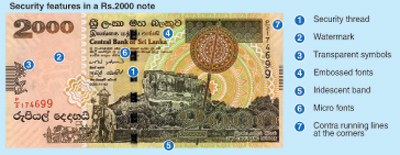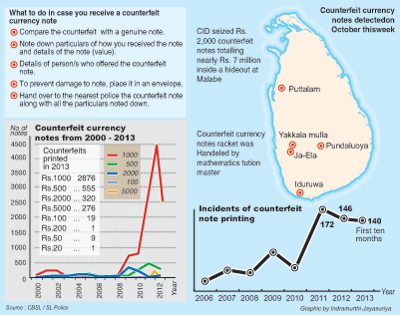News
Rs. 2000: A note of caution
A court official in Puttalam called over at a State bank on Thursday October 24, to deposit the day’s collection of fines. Counting the money, the bank assistant detected a forged 2,000-rupee note. The police were called in and a statement from the court officer was recorded.

Nuwan Kumara
On Tuesday, a shoe-shop owner paid in cash for a take-away parcel at a Chinese restaurant in Horana. The cashier, suspecting that the 2,000-rupee note he was given was a forged one, called in the police. When questioned, the shoe-shop owner said he had received the money from a woman who came to his shop to buy shoes.
Police traced the woman and recorded her statement and the shoe-shop owner’s. These were among 320 complaints of forged 2,000-rupee notes being detected in the past eight months. The chief suspect, a mathematics tuition master, had a network of countrywide ‘dealers’ to sneakily introduce the notes into the money flow. Investigations were continuing to ascertain the damage caused to the economy.
Criminal Investigations Department (CID) detectives raided the house of the tuition master, Nuwan Kumara, on Monday after they arrested one of his agents and exacted information from him. Detectives found some 850 forged 2,000-rupee notes at Kumara’s residence.
“The suspect has printed the two sides of the note separately and pasted them together to make it a single note,” an officer involved in the raid told the Sunday Times. The detectives also found printouts of some 2650 2,000-rupee notes with only one side of the note printed. The CID estimates that the forged notes — fully printed and partially printed — add up to Rs 7 million.
Once the printouts were cut and the forged notes were made, the detective said Kumara had sold a counterfeit 2,000-rupee note to his ‘dealers’ at Rs. 1,000. “The breakthrough came after months of investigations. Since, March this year the CID had received as many as 320 complaints from banks, shops, hotels, petrol sheds and state institutions,” the detective said.
The CID deployed decoys to pose off as racketeers interested in forged currency notes. The strategy worked. A CID decoy came across a man who wanted to sell 20,000 forged notes of the Rs. 2,000 denomination. He was arrested and interrogated. The detectives got the phone number of the tuition master from the suspect. This enabled them to locate his house in Malabe, where he printed the notes. His wife and two children lived in Watareka, Homagama.
On Monday, there was high drama when the CID surrounded his Malabe residence which he had rented out only two weeks ago. When the police knocked on the gate, Kumara was taking a bath. Seeing the policemen at the gate, he sensed trouble. Wearing a bath towel, he ran out of the house through the rear door and scaled the wall in the backyard. He climbed the roof of a neighbouring house and ran over several roofs in the area. By the time the detectives came to the backyard, the suspect had disappeared. But they knew he was in the vicinity and brought in sniffer dogs.
Soon they found the suspect hiding on a roof. He was arrested and the Kaduwela Magistrate remanded him until November 7.
Investigations reveal that Kumara was a fugitive. He had been arrested on four occasions in connection with printing forged notes. There are several warrants for his arrest from courts for violating bail conditions and absconding.

“We have found that the suspect had mastered the art of forgery. He has succeeded in forging even several security features such as the vertical silver thread and the lion symbol,” the detective said. A feature introduced to help visually handicapped people to recognise the note too has been included in the forged note.
The CID warned the public that the notes detected so far had the serial number P6779959 and urged them to contact the police if they came across one.
“If the investigations reveal that the person had accidentally got a forged note, the CID will only record a statement, but further investigations will be carried out if there is suspicion,” the officer said. The CID is on the lookout for other suspects involved in the printing and distribution of the forged currency notes.
Ways to identify forged currency notes
According to the Central Bank, the main feature that helps people distinguish a genuine note from a forged one is the watermark. Each denomination has a different bird as the watermark on the note. In addition, the value of the note in numerals appears vertically as a highlighted watermark.

Besides the watermarks, there is the security thread – the second most important security feature — which helps people to recognise a genuine note from a fake one. Security threads vary from denomination to denomination and have the letters CBSL and the value of the currency printed on it.
The width of the windowed starch-chrome thread which changes its colour from red to green and vice-versa in Rs. 5000, Rs. 1000 and Rs. 500 notes are 3mm, 2.5mm and 2mm respectively. The colour shifting feature in big denomination notes is a special security measure. It is a straight thread. In a counterfeit note, magnetic tapes resembling the thread are pasted on it.
The third security feature is the cornerstone watermark which appears in the form of diagonal bars at each corner of every currency note and the fourth feature is the ‘See Through’ factor. When the note is held up to the light, the numeral value of the note on the front comes together in perfect register with the reverse on the back of the note.
The fifth feature is the Extra Small Text, in a particular area. When viewed closely, the text in small print reads “CBSL” and the denomination of the note. The sixth feature is the Blind Recognition Feature, heavily printed dots in vertical order progressing according to the denomination appears on the left side of the currency note to help the visually impaired people to recognise the denomination.
The seventh feature is the Raised Print, when it is touched across the note the embossed print will be felt (eg- the Central Bank title, tactile bars, central images).
comments powered by Disqus
